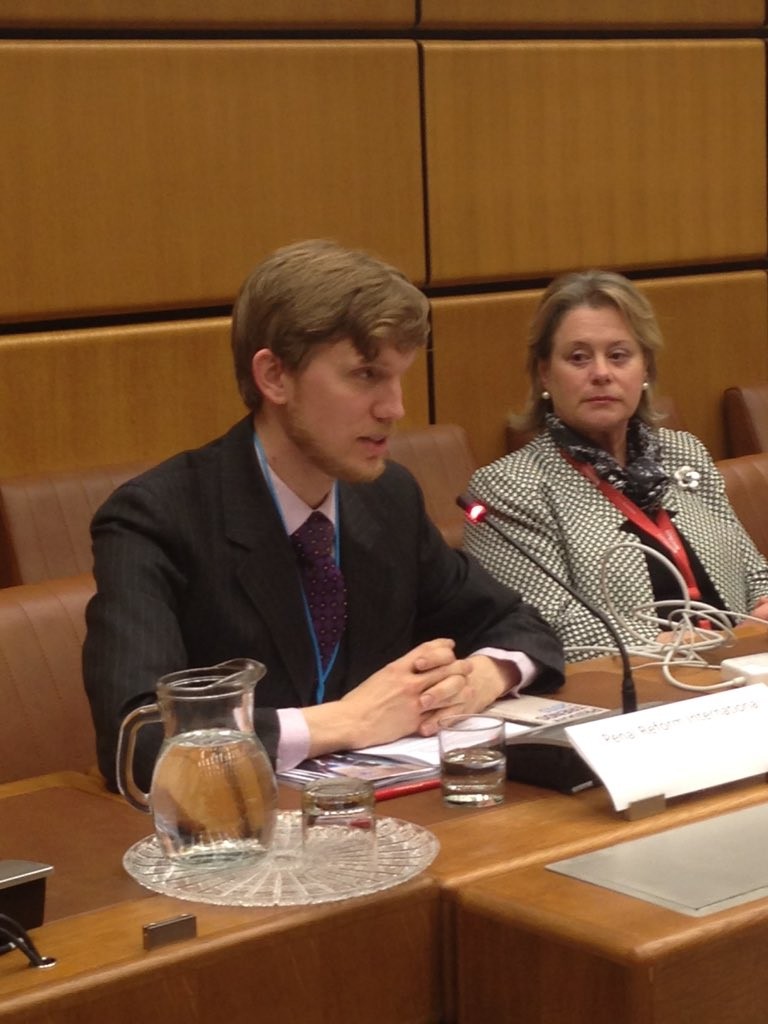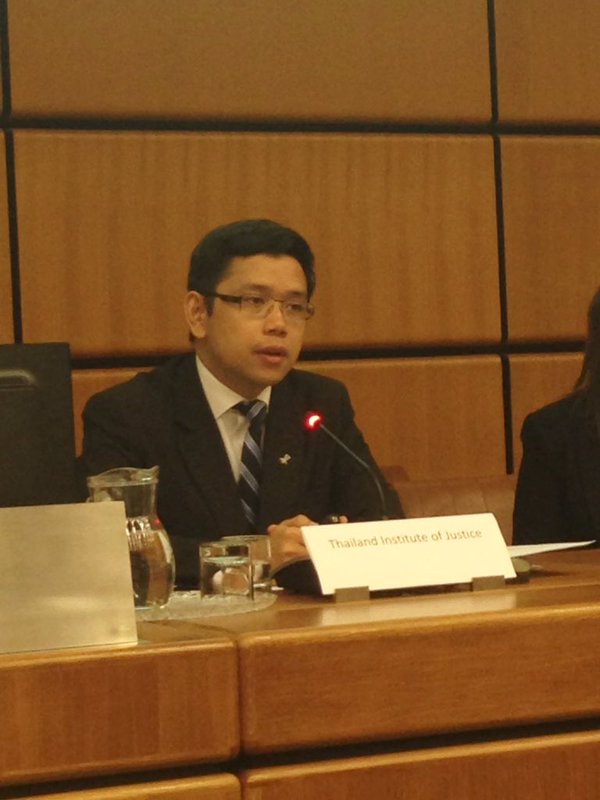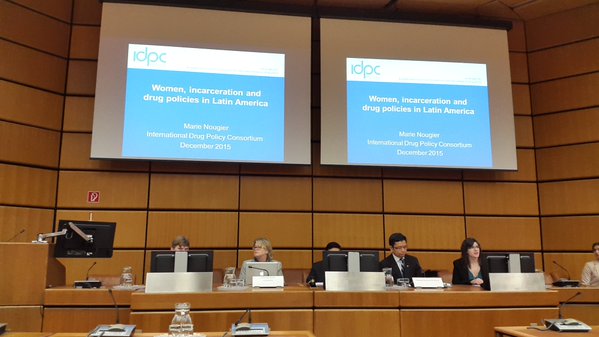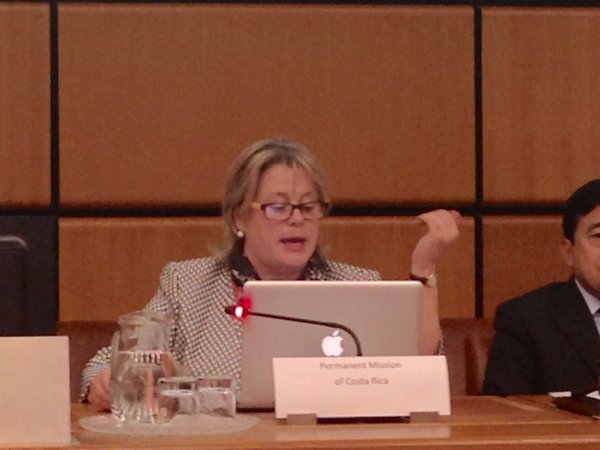Event organised by the International Drug Policy Consortium, the Thailand Institute of Justice, Penal Reform International, the Thailand Mission in Vienna and the Costa Rica Mission in Vienna.
Ambassador of Thailand in Vienna
There are now high rates of imprisonment for drug offences in several regions of the world, giving rise to the need to consider issues such as proportionate sentencing for drug offences, to address problems such as prison overcrowding.
Oliver Robertson, Penal Reform International
PRI believes in criminal justice systems that are fit for purpose, where sentences are proportionate, and in abolition of the death penalty. When it comes to women, we can’t help but come across problems caused by the war on drugs, which is responsible for the rise in female prison population. Prison systems often approach drug offenders in a very punitive way, and do not provide drug dependence treatment or healthcare, especially those catering to the specific needs of women.
In relation to the increase in imprisonment for drug offences, we need to ask whether it is the kingpins who are in prison. They are not, the majority of people prosecuted for drug offences are low-level offenders, eg. possession only, as shown in 2013 UNODC report, especially in Africa and Asia. 83% of drug offenders in prison are sentenced with possession offences. Why do we have these trends? Criminal sanctions for drug offences vary widely across countries, but there is little difference in sentencing between use and trafficking, different types of drugs and different roles in drug operations. Up to 71% of women in prison are held for drug offences, more than for men, reflecting the gender disparities in the consequences of the war on drugs. Women’s primary role in drug markets are as mules, they can also be caught up in trafficking work of husbands and partners, eg. in Mexico, 40% of women imprisoned for drug offences were coerced into doing so by boyfriends and husbands. The idea behind harsh punishment is to deter drug offences but this has evidently not been effective in reducing drug markets. A study in the UK shows that drug use is driven by complex and nuanced factors rather than being deterred by law enforcement measures alone.
Large numbers of people who use drugs come from impoverished, marginalized background. Criminalisation drives them further into poverty, and jeopardizing opportunities for housing and employment. There are other negative consequences, eg. higher risks of HIV including from exarcerbation in poor prison conditions. Prison can be an unsuitable environment with which to deal with drug dependency. Also, when we focus on low level offenders, we are not doing anything about serious offenders.
Dr Phiset Saardyen, Director, Office of External Relations and Policy Coordination, Thailand Institute of Justice
The reason we think it is crucial to take a careful look at drug policy is from looking at Thailand alone, the majority of people in prison are held for drug offences (80.5% of females and 68.2% of males in prison from studies conducted this year).
Prison overcrowding is a problem in other ASEAN countries. Thailand has the 6th highest prison population in the world, with Indonesia 10th, and Vietnam 12th. Throughout the region we have found that a range of alternatives to incarceration have been introduced. In Cambodia, a drug dependent offender charged with possession or consumption may be ordered to compulsory drug treatment for an unspecified period, with a 5-year pilot program of community-based drug treatment set to be launched. In Indonesia the law requires compulsory reporting, and diversion to community-based treatment does exist. In Thailand, diversion schemes have been instituted to divert people dependent on drugs to compulsory treatment (custodial or non-custodial) or voluntary treatment. But there are problems with people being sent to prison for consumption alone.
In many countries in Southeast Asia, criminalization is still a common approach to drug use, and low threshold quantities for drug offences result in court and prison overcrowding.
What are prospects for Thailand making drug policy more proportionate? Thailand is drafting a new narcotic code which will better distinguish between major drug traffickers (up to 30 y, life imprisonment or death penalty), small-scale drug dealers (20 for production, 10 or 5 years for users who distribute drugs to other users) and drug users (2 years for possession with intent to use, 1 year for drug use). The system will enable people arrested for drug use to be diverted to voluntary treatment, but at the 6th arrest the person will be sent to compulsory detention.
What is the way forward? The persistent attitude and policy amongst law enforcement officers and the public needs to shift from overwhelming focus on punishment. There also needs to be greater use of alternatives to incarceration.
Marie Nougier, International Drug Policy Consortium:
There are a number of regions around the world where the imposition of disproportionately long prison sentences for drug offences have fuelled mass incarceration. Latin America is no exception, but this is particularly the case for women.
Although women are a minority of those incarcerated, they are the fastest growing prison population and this is mainly due to repressive drug laws and policies. If we look at numbers, between 2006 and 2011, the number of women incarcerated in the region nearly doubled, from 40,000 to 74,000. And if we consider the proportion of women incarcerated for drug offences country by country, the percentage is very high, reaching 42% in Colombia, 60% in Brazil, or almost 80% in Ecuador.
However, when we look at the profiles of those incarcerated, they do not fit the stereotype of a high level, violent criminal.
And to illustrate this point, I would like to start off by sharing a real story, that of a woman who is currently incarcerated for a drug offence in Costa Rica. Lidieth’s story is one among many others, and it highlights many important points about the failures of our current approach to drug control.
Lidieth, a 45-year-old mother of four, says she was arrested for selling small quantities of crack and cocaine from her home in order to feed her family. Two of her adult children were implicated in the household business and sent to prison as well. Even from behind bars, she continues to care for her two youngest children, one of which she fears is being abused at home. She is currently serving a plea-bargained sentence of five years and four months. Her full story is available here: http://www.wola.org/commentary/women_behind_bars_the_human_cost_of_current_drug_policy_in_the_americas.
Lidieth’s story is all too common, and this is the profile of women incarcerated across the region:
- They are condemned for low-level, non-violent drug offences.
- They are first time offenders
- They are single mothers of several children or care for elderly dependents
- They have low levels of formal education and have limited prospects in the licit economy
- They are often driven by economic needs, generally to support their children and/or other dependents
- Some are coerced by male partners or family members
- Ethnic, indigenous or foreign women are in a particularly vulnerable position.
The imprisonment of these women has a significant impact on their lives, which in our work we often describe as a “triple stigma”:
- First the criminal justice system condemns them, then incarcerates them for a disproportionate amount of time in penitentiary centres that are poorly equipped to meet their gender specific needs, and that of their children. In fact, children often have no other choice than to live in the street or go to prison with their mother.
- Second, they are condemned and stigmatised by society for breaking the traditional image of women as caregivers, and
- Finally, upon release from prison women continue to be punished and pushed at the margins of society because of their criminal record, often making it impossible for them to find employment in the licit economy. This leads to a vicious cycle of poverty and crime.
This issue has gained prominence across Latin America, both at regional level with a series of events being organised by the Organisation of American States, and at national level, with movements for reform.
These have included:
- Amnesties for women incarcerated for low-level drug offences, such as in Bolivia and Ecuador
- Alternatives to incarceration – these are being discussed by a number of governments in the region, and the publication of a fantastic report by CICAD on the issue. This month, an Argentinian judge called for home arrest for pregnant women or women who breast-feed their baby.
- Legislative reform:
- Ecuador adopted a new criminal code last year which significantly reduced prison sentences for low-level drug offences – although we were concerned by the move last September to lower threshold quantities to very low levels
- And Costa Rica which significantly reduced prison sentences for women introducing drugs in prison, and which established a solid network of support services for former female prisoners to help them reintegrate into society. I will not say more on this as we have the pleasure to have with us The Costa Rican Ambassador who will say a few words about the reform.
IDPC, in collaboration with WOLA, DeJusticia in Colombia, the Inter-American Commission on Women and ACEID in Costa Rica, are working on a set of recommendations to reform drug policies with the objective of reducing the incarceration of women in the region. These guidelines will be available soon and we will present them at the 2016 CND next March.
Recommendations:
- It is clear that we need for more data to assess the scale and impact of incarceration of women for drug offences
- Harsh prison sentences have done more harm than good. It is critical that sentences be proportionate, and take due account of mitigating factors such as poverty, vulnerability, being a first time offender, being pregnant or the sole carer of children, etc.
- Alternatives to incarceration should be implemented so that prison is used only as a last resort for women in situation of vulnerability involved in drug offences – the focus should be on interventions that seek to reduce the socio-economic and personal factors that lead women to engage in the drug trade in the first place.
Ambassador of Costa Rica in Vienna
I will speak on alternatives to incarceration in Costa Rica, and the gender-specific characteristics. By way of background, drug consumption was dealt with by Ministry of Health and punishment for supply offences was punished by mandatory sentences of 8 – 20 years in prison in the 1988 – 1991 drug laws, reduced to 5-8 years prison in 2002. These harsh penalties were implemented due to international pressure to appear tough on drugs, and wanting to appear as a good international collaborative partner.
What changed? The realisation of negative impact of incarcerating minor offenders and women, especially vulnerable women, on families in particular, which led to international commitments such as the Bangkok Rules.
Data on women in detention in Costa Rica: 78.5% under 44 years of age, 90% are mothers, average 3.13% children, 64% of children under 18 years, 20% didn’t finish primary school, 20% completed primary school. 80% are in detention for first time, 81% currently detained for drug offences including for production, trafficking and selling.
Criteria used to determine whether a woman qualifies for alternative to incarceration programme: poverty, head of household in condition of vulnerability, dependants (minors, disabled and the elderly), over 65. In 2013, 159 female inmates were released under this programme. Government also established a support platform for women, for network of government agencies to provide comprehensive range of care services for vulnerable women under criminal proceedings for drug offences and their families, eg. child services, legal assistance. The areas of intervention for this government network covers 4 areas including health (eg. drug dependence treatment), and economic hardship, providing assistance to women in detention and in the alternative measure programme. The programme includes locating women released from prison to see if any assistance can be offered to them, including subsidies.
The war on drugs has not been effective and resulted in a lot of negative consequences. We need to shift from law-enforcement focused policies and develop policies based on scientific evidence and consideration of broad range of factors including social, biological and cultural.




